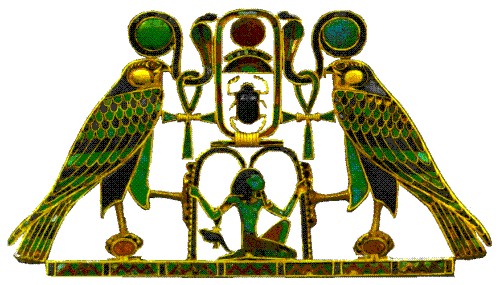

A great interest of mine, and of many people, involves everything ancient Egyptian. With these people in mind, I'll show how an item of sacred jewelry, a necklace of Princess Sit-hathor-yunet, was designed using a beautiful geometric scheme.
 Pectoral of Princess Sit-hathor-yunet
Pectoral of Princess Sit-hathor-yunet
Metropolitan Museum of Art in New York
Owner Credit: Rogers Fund and Henry Walters Gift, 1916
Costume and Jewelry Accession Number: MMA_.16.
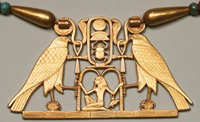 Back
Back
This lovely pectoral, worn upon the chest ("pectoral muscles"), is only 3-1/4 inches in length and comes to us from the reign of Pharaoh Senwosret II circa 1897-1878 BC. It's made of solid gold in the cloisonne style, inlaid with 372 carefully cut pieces of semiprecious stones including carnelian, feldspar, garnet and turquoise. You can see it on display in the Egyptian wing of the great Metropolitan Museum of Art in New York. A mirror there allows us to view its solid gold back.
It was found among other jewelry of Princess Sit-hathor-yunet in a special niche of her underground tomb beside the pyramid of Senwosret II at Lahun. Since the tomb of the princess was beside the main pyramid, scholars speculate that she was his daughter.
The pictures of the pectoral are actually hieroglyphs which tell a creation myth. At it's base, the zigzag lines in the seven sections represent the primordial waters out of which the primeval hill emerged, over which the primordial sun, Re, first arose, rolling up and across the sky pushed by the scarab beetle "Kheper". Each of the pectoral's falcons, solar symbols, clasps a circular shen ring hieroglyph meaning "eternity". The same glyph is elongated at the center forming a cartouche enclosing the glyphs of the throne name of Senwosret II: Khai-kheper-re ("The Soul of Re Comes Into Being", which is what the pharaoh sought in himself). On each side of the king's name are two ankh ("life") hieroglyphs suspended from cobras whose tails emerge from the sun disks on the falcons' heads. These cobras represent Nekhbet and Udjo, traditional protector goddesses of the pharaoh. Beneath the cartouche kneels the god Heh clutching two palm rib glyphs signifying "time" which emerge from his head, symbolizing "millions of years". Hanging upon one arm is a tadpole, the glyph meaning "one hundred thousand". If you've ever seen tadpoles in water, you'll know why the tadpole glyph represents a large number. Notice that each falcon has one foot standing on "eternity" and the other foot raised leaning on "time".
Simply put, the pectoral's pictures may be read: "The god of the rising sun grants life and dominion to Pharaoh "The Soul of Re Comes Into Being" over all that the sun encircles for one million one hundred thousand years."
Like all sacred "art" of ancient Egypt, as well as most other cultures, this pectoral was designed according to a "magical" formula combining mythology, color symbolism, material symbolism and using mathematics as a symbolic language of number and shape as taught by number itself, and expressed as the geometric forms of nature.
Such a "mathemagical" design is openly hidden in this pectoral of Princess Sit-hathor-yunet, having a geometric scheme shared by many other examples around the world including this pectoral of Princess Mereret. To understand it's geometric design framework, one must first refer to Egyptian mythology, language, and thinking. At the center of the pectoral we see a black scarab beetle, kheper, a glyph/word which means both "to exist" and "to transform". (Black, the absence of color, also symbolized transformation to the Egyptians. Their name for their land, Kem-t, "the Black Land", refers both to the dark silt of the Nile which transforms from death to life in plants, and also to the transformative nature of their religion. From Kem-t we derive the words "alchemy" and "chemistry".) The scarab's tail is the location from which the egg of the sun was born, rolled above the horizon out of the primordial waters of undefined chaos to bring the universe, the organized cosmos, into existence. Overseeing this harmonious order is the sun's role as it transforms across the sky each day. In a sense, kheper's tail is at the center of the myth, and it is certainly the exact center of the geometric construction on which the pectoral was apparently designed. So, to Egyptian thinking, it all starts there, at the same symbolic center of creation, the egg/point from which the universe, the geometric scheme of this pectoral, and the pectoral itself, emerge.
From this central point extends a radius which turns to become a circle. In it is inscribed an equilateral triangle (below). First, notice that the triangle's baseline runs along the bottom of the bar representing the primordial waters. Notice also how the triangle's sides skim the snakes wrapped around the suns, and continue downward becoming tangent to the tails of the falcons. This pectoral was clearly designed to fit in an equilateral triangle. Triangles, trinities, triples and threeness generally symbolize something sacred, divine, as in the statement of this pectoral.
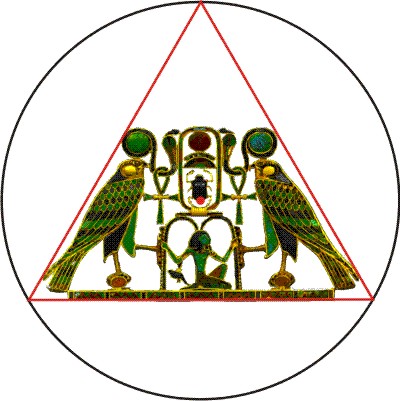
The original upward triangle reflects to make a hexagram star, perhaps the simplest geometric form to construct (since the radius of any fixed compass will "walk" around its own circle's circumference precisely six times). Notice how the downward triangle's sides pass through the falcon's knees and skim by its claws holding the shen glyphs.
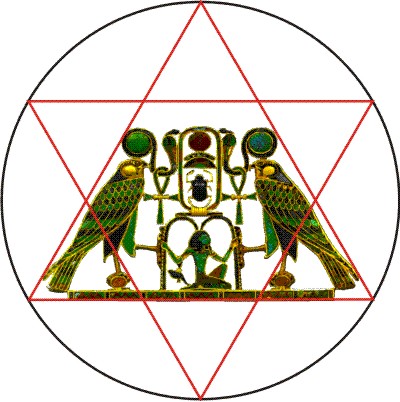
To appreciate the rest of the construction, it's useful to know something about the geometry of the hexagon and its hexagram star. The essential relationship in a hexagon is the "root-three" or "square root of three to 1" ratio, a value which when multiplied by itself equals 3 (approximately 1.732...). The large green rectangle in the hexagon (below, left) is a "root three rectangle" since its sides are in this ratio. A hexagon and its hexagram star are the visible expressions of the root-three ratio. When a hexagram star is constructed within in its central hexagon (below, center), it replicates this same ratio in a smaller size., dividing the large root-three rectangle into three smaller, turned versions of itself. The third diagram (below right) show how the root-three ratio recurs as a series of smaller and smaller rectangles. As hexagrams are constructed inward, the resulting colored rectangles are smaller sizes yet always maintain the same root-three-to-1 ratio. All rectangles resemble one another. The effect is a design which conveys a sense of unity, cohesion and wholeness.
So, by constructing hexagrams within each hexagram star, the armature by which the pectoral's visible features are guided gradually emerge. Some placements are obvious. Others take some time to appreciate and understand. The red hexagram (below, left) divides the main root-three rectangle into three smaller, turned root-three rectangles. Notice how the vertical lines of the red hexagram, which are the sides of the central root-three rectangle, precisely define the limits of the falcons' bodies, marking the divisions of the large root-three rectangle into thirds. These lines also define the outer side of the arms of the ankh glyphs. In the picture below right, a red square was drawn in the upper part of the central root-three rectangle. Notice how the pharaoh's cartouche rests upon the base of this symbol of the earthly realm, and also marks the tops of the curved palm fronds. Little by little, different aspects of the composition reveal themselves as its ancient designer, a master artisan-maathematician-priest, must have planned it nearly 39 centuries ago.
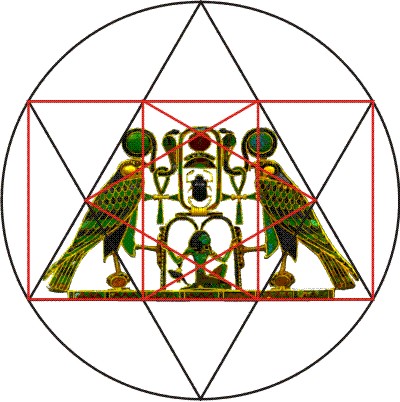
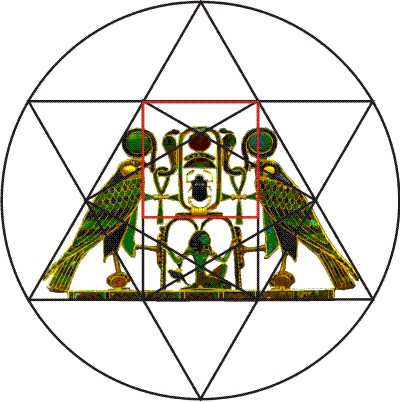
Another red hexagram (below left) connects the crossings of the previous hexagram to divide the central scene into three smaller root-three rectangles. Notice how this rectangle defines the top of each ankh, its loops framed in their own small triangles above the crossings at the ankh's centers. Between them, the line skims just above the scarab, and another crosses Heh's crown from which the palm fronds, representing "time", emerge. This subdivision is extended (below right) across the full root-three rectangle to reveal it made of a frame of nine smaller, identical root-three rectangles.
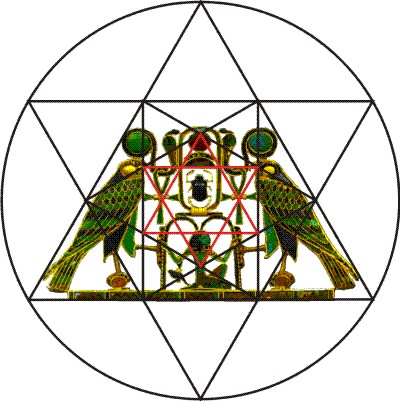
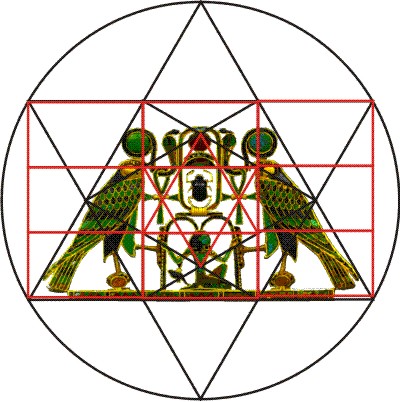
A fourth red hexagram is constructed (below left) within the previous hexagram, dividing the central space into three even smaller vertical root-three rectangles. Notice that it reveals the width of the central cartouche containing the pharaoh's throne name, as well as the other side of the ankh's arms.
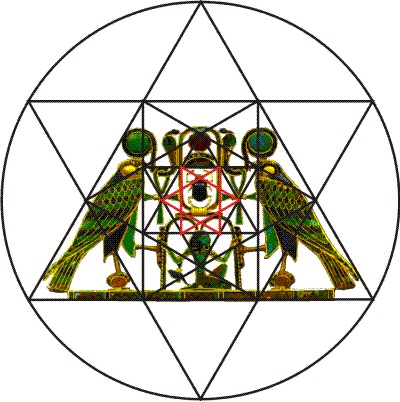
Below left, the small root-three rectangles have been extended to fill the central root-three rectangle. Below right, blue lines divide these small root-three rectangles in half vertically to show more detail. Notice how the snakes' faces rest upon a line, as do the arms of each ankh, and Heh's elbows below them.


A fifth red hexagram (below left) is drawn within the previous one defining the bottom of the cartouche's oval. And finally (below right) the sixth six-pointed star takes us to the unit-width of the original scarab beetle. From its tail came the small egg initiating the entire creation of cosmos, which this pectoral's design was made to resemble.
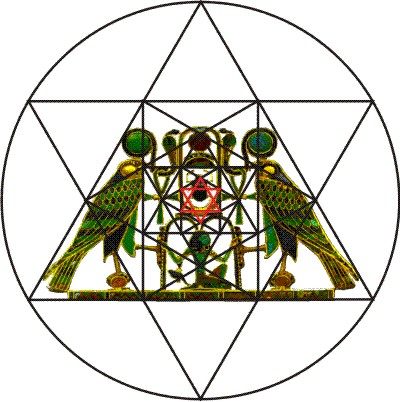
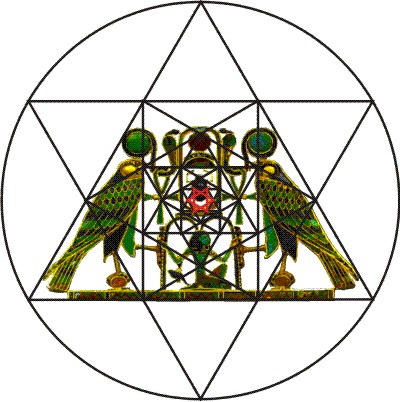
This is the pectoral's essential design geometry, but the general public was not meant to see this aspect of it. For the design to be useful to jewelry designers, painters, sculptors and others, the original geometry was removed and a "cartesian" graph-paper grid (below) was overlaid.

This grid hides the real design but makes it very simple to reproduce in any size, from a small pectoral to a sculpture on the side of a mountain, by copying the picture cell by cell. But only the mathematician-priests knew the original design based on geometric and other symbolism, and mythology. Don't expect to find an extant papyrus where this this process is explicitly described. Egyptologists are only aware the grid patterning, and there are references to lost "pattern books". Look carefully at Egyptian works in museums like the great Metropolitan Museum of Art in New York and you'll surely come across unfinished pieces where the grid is still visible. But you only need to explore their works with a knowledge of geometry and an appreciation of Egyptian thinking, and the original construction will reveal itself to you. The geometric analysis of another pectoral of Princess Sit-Hathor-Yunet can be found here.
Here's an animated version of this geometric construction over the pectoral to give you a feel for its unfolding proportion:

==================================
If you enjoy doing geometric constructions
or want to learn how,
consider these workbook companions to
"A Beginner's Guide To Constructing The Universe"
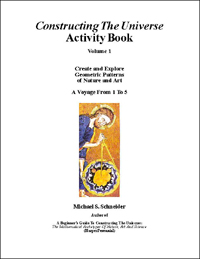
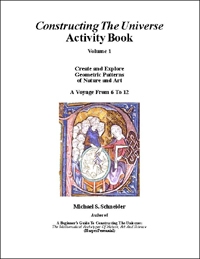
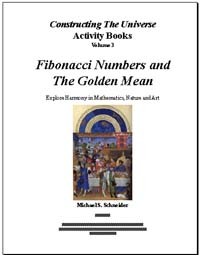


... including a great deal of Egyptian art!
Available Only Through This Website!
Click here to learn about these Activity Books
and see their Tables Of Contents.
Back to the Constructing The Universe home page.